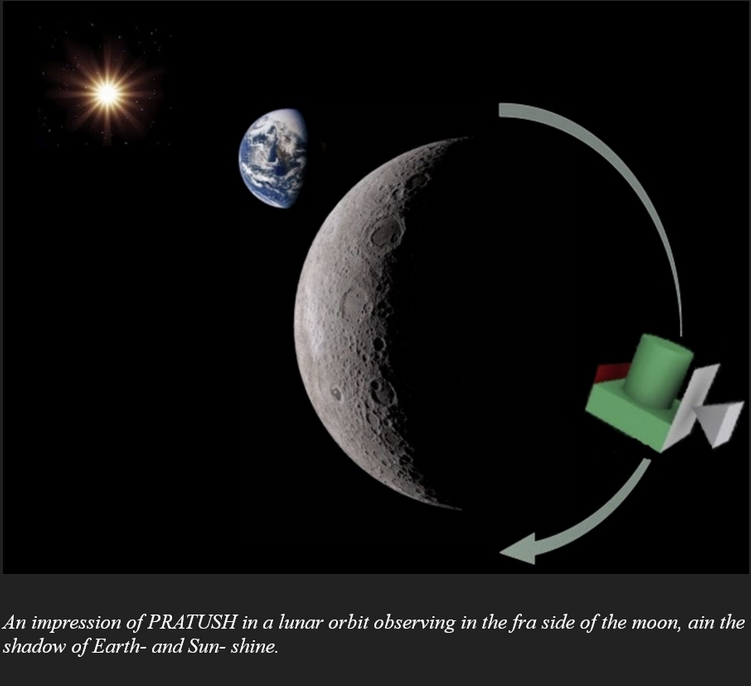Important Facts For Prelims
PRATUSH Telescope
- 19 Apr 2024
- 7 min read
Why in the News?
Astronomers globally are anticipating a new era of exploration with high-resolution telescopes set to be placed on the moon and in orbit around it. Various proposals, like India's PRATUSH (Probing ReionizATion of the Universe using Signal from Hydrogen), aim to open this new window to the universe.
What is PRATUSH?
- About:
- PRATUSH is a radio telescope designed to be placed on the far side of the moon. It is built by Raman Research Institute (RRI), Bengaluru and Indian Space Research Organisation (ISRO).
- Objective:
- It aims to uncover the timing and characteristics of the first stars' formation in the universe, including the colour of the light during Cosmic Dawn.
- It will unveil the evolution of our early universe from its initial cold gas state to the formation of stars, galaxies, and the universe as we observe it today post-Big Bang.
- The Cosmic Dawn marks the period when the first sources of radiation, such as stars and galaxies, formed in the universe.
- Capabilities:
- PRATUSH will carry advanced radio equipment covering a wide frequency range from 30 to 250 MHz.
- It will observe large sky areas continuously, recording detailed radio spectra with a resolution of 100 kHz.
- It includes a custom-designed antenna, analog receiver, and digital correlator for high-resolution spectral analysis.
- The goal is to achieve a sensitivity level of a few millikelvin with precise
- Millikelvins (mK) are a unit of measurement used to express temperature on the Kelvin scale, where 1 millikelvin is equal to 1000 of a Kelvin.
- It is designed for a two-year mission in a circumlunar orbit to avoid interference and achieve optimal radio sky measurements.
- PRATUSH will carry advanced radio equipment covering a wide frequency range from 30 to 250 MHz.
What are the Other Global Missions Related to Telescopes on the Moon?
- Lunar Surface Electromagnetic Experiment (LuSEE) Night Project: It is a collaboration between NASA and Berkeley Lab and aims to land on the moon's far side. It is scheduled for launch in December 2025.
- NASA's Long-Baseline Optical Imaging Interferometer: It will be launched in parts and be assembled on the moon's far side.
- It will study magnetic activity in stars and galaxies using visible and ultraviolet wavelengths.
- ESA’s Argonaut: European Space Agency plans to launch a Radio Telescope aboard its lunar lander, 'Argonaut', by 2030, along with other projects focusing on gravitational wave detection and infrared observations.
- China's Moon-Orbiting Radio Telescope: China is set to launch a moon-orbiting radio telescope in 2026, positioning itself at the forefront of lunar exploration and astronomical research.
- The Queqiao-2 satellite, deployed in lunar orbit, carries a 4.2-meter antenna for radio astronomy.
What are Telescopes?
- About: Telescopes are devices designed to gather and focus light to form magnified images of distant objects.
- Developed over centuries, with early telescopes credited to inventors like Galileo Galilei and Johannes Kepler in the 17th century.
- Function: Telescopes gather and magnify light from space, allowing astronomers to study celestial objects in detail.
- They help observe distant objects, map the sky, study cosmic events, detect exoplanets, and explore different wavelengths of electromagnetic radiation, enhancing our understanding of the universe.
- Telescopes use lenses or mirrors to collect and concentrate light, resulting in an enlarged and clearer view of celestial objects.
- Types of Telescopes:
- Catadioptric or Compound Telescopes: Combine both lenses and mirrors for focusing light.
- Examples: Schmidt-Cassegrain and Maksutov-Cassegrain telescopes.
- Radio Telescopes: Detect radio waves emitted by celestial objects. Comprise large dish antennas and receivers.
- Example: Giant Metrewave Radio Telescope (GMRT), Pune.
- Space Telescopes: It is a telescope in outer space used to observe astronomical objects.
- Examples: Hubble Space Telescope (a reflecting telescope) and the James Webb Space Telescope(a reflecting telescope).
- Catadioptric or Compound Telescopes: Combine both lenses and mirrors for focusing light.
Note
NASA is planning the next big space telescope, called the Habitable Worlds Observatory (HWO). This telescope focuses on ultraviolet, visible, and near-infrared wavelengths, ideal for searching for potentially habitable exoplanets. The project is currently in its initial development phase.
UPSC Civil Service Examination, Previous Year Questions(PYQs)
Prelims:
Q 1. In the context of space technology, what is “Bhuvan”, recently in the news? (2010)
A. A mini-satellite launched by ISRO to promote distance education in India
B. The name given to the next Moon Impact Probe, for Chandrayan-II
C. A geoportal of ISRO with 3D imaging capabilities of India
D. A space telescope developed by India
Ans: C
Q.2 In the context of modern scientific research, consider the following statements about ‘IceCube’, a particle detector located at South Pole, which was recently in the news: (2015)
- It is the world’s largest neutrino detector, encompassing a cubic kilometre of ice.
- It is a powerful telescope to search for dark matter.
- It is buried deep in the ice.
Which of the statements given above is/are correct ?
(a) 1 only
(b) 2 and 3 only
(c) 1 and 3 only
(d) 1, 2 and 3
Ans: D





